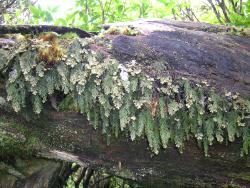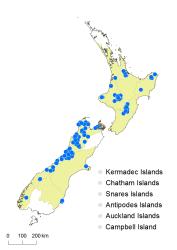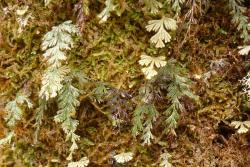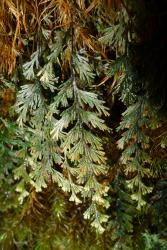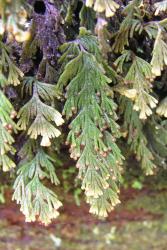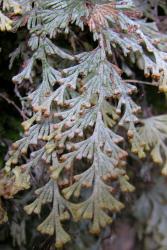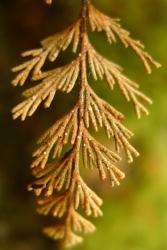- ≡ Trichomanes malingii Hook., Gard. Ferns t. 64 (1862)
- ≡ Apteropteris malingii (Hook.) Copel., Philipp. J. Sci. 67: 35, t. 1 (1938)
- ≡ Sphaerocionium malingii (Hook.) K.Iwats., J. Fac. Sci. Univ. Tokyo, Sect. 3, Bot. 13: 214 (1982)
Usually epiphytic ferns, rarely terrestrial or rupestral. Rhizomes long-creeping, 0.25–0.5 mm diameter, bearing stellate pale red-brown hairs up to 1 mm long, densely clustered at bases of stipes, more evenly distributed elsewhere. Fronds 40–360 mm long. Stipes 10–100 mm long, reddish brown, not winged, bearing pale brown stellate hairs, especially near rachis and rhizome junctions. Laminae 3–4-pinnate, narrowly ovate or ovate or narrowly elliptic, 25–310 mm long, 8–55 mm wide, segments comprised entirely of enlarged costae, completely covered in grey stellate hairs on adaxial surface and rusty-brown stellate hairs on abaxial surface. Rachises not winged, completely covered in grey or red-brown stellate hairs. Primary pinnae in 5–30 pairs, not overlapping, not winged, narrowly elliptic or elliptic or narrowly ovate or ovate, stalked; distal portion of primary pinnae straight or slightly incurved acroscopically; the longest primary pinnae near the base (or rarely near the apex in large aberrant fronds), 9–60 mm long, 3–12 mm wide. Secondary pinnae arising both acroscopically and basiscopically, not overlapping, not winged, stalked; linear or obovate on distal primary pinnae, elliptic or obovate on proximal primary pinnae; the longest secondary pinnae 4–10 mm long, 1–5 mm wide. Ultimate lamina segments linear, up to 4 mm long, 0.4–0.7 mm wide, comprised entirely of enlarged costae; apices obtuse or truncate; margins entire; distal segments on primary pinnae divergent. Sori terminating ultimate segments throughout pinnae, solitary, many on each primary pinna, immersed in lamina; indusia bivalvate; indusial flaps elliptic or broadly elliptic or broader than long, 0.5–1 mm long, completely covered by hairs; receptacles usually slightly exserted.
Hymenophyllum malingii is immediately recognisable by the complete covering of dense grey stellate hairs on the adaxial lamina surface, and rusty-brown stellate hairs on the abaxial surface. The laminae are usually narrowly ovate, and the lamina segments are almost round in cross-section, comprised entirely of enlarged costae. The only other New Zealand filmy ferns with branched hairs are H. lyallii, which has a light green flabellate frond with minute teeth and bifurcate hairs on the margins, and H. frankliniae, which has stellate tawny or rusty-brown hairs on the lamina surfaces. Unlike H. malingii, H. frankliniae has "normal" flattened lamina segments adjacent to the costae, and unbranched hairs on the rhizome.
North Island: Auckland, Volcanic Plateau, Gisborne, Taranaki, Southern North Island.
South Island: Western Nelson, Sounds-Nelson, Westland, Canterbury, Otago, Fiordland.
Altitudinal range: 80–1380 m.
Hymenophyllum malingii occurs in montane and subalpine areas of the North Island from Mt Te Aroha and the Raukūmara Ranges southwards, occurring most frequently on Mt Taranaki, the central North Island mountains, and Ruahine Ranges. It grows from about 630 m near National Park to 1380 m in the Ruahine Ranges. In the South Island, it occurs mainly west of the main divide in lowland to subalpine areas from Nelson to Haast, with outlying populations in the Mt Aspiring National Park, and around Dunedin and Lake Manapouri. It extends from about 80 m in the Westport area to 1200 m in north-west Nelson.
The record of Hymenophyllum malingii from Banks Peninsula is based on two specimens in the Armstrong Herbarium (CHR 633530) collected in 1868 and 1873 from Church Bay, Lyttleton Harbour, and reports of it from near Port Levy by Potts (1878, 1882, pp. 64–65, 249). However, the species has not been seen on Banks Peninsula since, and it is presumed to be locally extinct (Wilson 2013).
Occurs most frequently on dead trunks of Libocedrus bidwillii, more rarely on trunks of Halocarpus biformis, Metrosideros umbellata, species of Nothofagaceae, and occasionally on boulders, rock faces and banks in montane beech or podocarp forest, or in subalpine tussock.
n = 36 (Brownlie 1965).
In addition to the lectotype chosen by Tindale (1963) there are two other syntype specimens at K: between Blind Bay and Massacre Bay, Brunner, Herbarium Hookerianum, K! (photo WELT E468/23), and New Zealand, Nelson, Golden Bay Ranges, C. Maling, Herbarium Hookerianum, K! (photo WELT E468/25).



